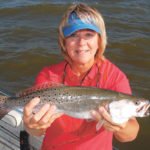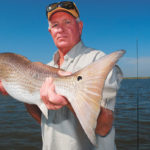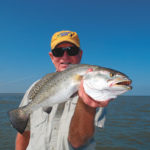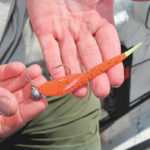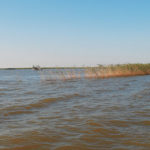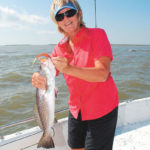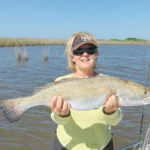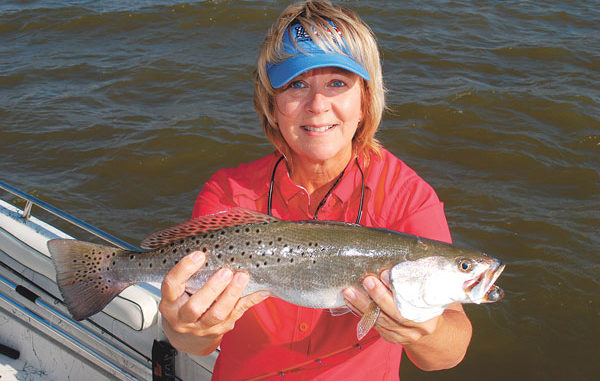
Couple tag-teams Venice autumn specks
I first met Gail Curtis because of a big fish — a 7.1-pound speckled trout with which she won the Ladies Division of the 2009 Gulf Coast Conservation Association STAR Tournament. She caught the winning fish on a live croaker under a sliding cork at the Southwest Pass rock jetties at the mouth of the Mississippi River.
While I talked to the attractive blue-eyed blonde about her catch, her husband Gene walked up and joined the conversation. They explained that while their official residence is in Hattiesburg, Miss., they spend half their time in Boothville, where they own the Little Fish Apartments.
Both are retired and now spend their time fishing, traveling and playing golf. After a little more chatter, she suggested that I might want to come down the river to fish with them.
So I did.
It took a year, but in October I turned up at the Little Fish, looking like a beggar needing a place to rest. October can be a tough month in the Venice area. The specks are moving out of their summertime coastal pattern, but haven’t yet fallen into their inside winter pattern. This could test their fishing skills.
After a leisurely, after-daylight breakfast at their Little Fish apartment the next morning, the couple trailered their boat to Venice for the run downriver. It’s hard to believe that such leisurely fishermen can catch such big trout. Earlier in the year, Gail caught a 7.2-pound speck in Redfish Bay on the same day that Gene caught a 6.8-pounder.
During the boat run, they showed their enthusiasm for the Mississippi River delta.
“We love it down here,” gushed Gail. “All the wildlife — you never know what you’re going to see. You feel so free here.”
Gene added his thoughts.
“We might be off-base,” he said. “We love to catch fish as much as anyone, but the wildlife here is so beautiful. We are so sad about losing our marshes.”
It was fall, but it smelled like spring. A southerly air flow was bringing Gulf moisture in to the dry autumn air of the last month. The air was fresh but nippy. Gail snuggled up next to Gene on the center console seat, and gave him a spontaneous hug. I felt like a privileged intruder.
The boat slipped from the big brown waters of the river into Octave Pass. The 8-foot tall roseau canes were still green and mixed with lush stands of cattails. Eastern baccharis bushes were starting to bloom, joining the marsh hibiscus, which were well into full flower. The occasional blossoms of water hyacinth splashed dashes of lavender into the scene. Big elephant ear leaves added a tropical look.
The delta was a profusion of life as lush as the Garden of Eden.
Gail turned and pointed out where they commonly see deer and alligators in the narrow pass. At one point, she noted where they saw a manatee.
I could almost imagine finding the Garden’s proverbial apple tree around the next bend in the bayou. All seemed so well.
Gene flared the boat into Flatboat Pass. The couple sat close together and swayed in unison as the 23-foot Bay Hawk wended its way down the crooked waterway, across Bay Joe Brown and jumped into Raphael Pass.
As the pass opened into Gulf waters, the Block 69 rigs, a famous summertime speckled trout destination, appeared in view. Only then did Gene slow the boat to an idle and then a stop. He explained the day’s strategy.
Since the fish would not be locked into either a summertime or a wintertime pattern, we would hit the small points of roseau canes that extended out from the main stands of canes on the delta. These, he felt, would be areas that would likely hold fish moving from the outside into the interior marshes. We would move in a big semi-circle around the edge of the marsh likely ending up near South Pass.
Gene slipped a live shrimp on a hook a foot and a half under a popping cork, while Gail tossed a clear 3-inch Hybrid Flurry soft plastic minnow. Both cast directly to the point of roseau canes and probed all around it as well.
Gene picked up speckled trout at a modest but steady pace. Gail got few bites on the Flurry minnow.
“Gail doesn’t like fishing with live bait,” explained Gene.
Gail retorted.
“Don’t get me wrong,” she said, “I’m not stubborn. I’ll fish with live bait if I have to.”
But she still didn’t give up on the soft-plastic lure. While they fished, I asked how long they’ve been married.
“We got married in 1997, but we have known each other since high school,” answered Gail.
“We were high school sweethearts,” echoed Gene.
“The Vietnam War was on,” Gail explained, “and he went to the army and I went to college. We both married other people and got divorced.”
“Then and now,” Gene gently interrupted to explain, “we liked each other more than we loved each other.
“She is my best buddy. We kept in occasional touch. I always loved her — then I found out that she loved me too. We both lost marriages at the same time.
“I started fishing Venice in the mid-1980s. It was love at first sight. I love the area. I love the people. These people are tough! For them to endure what they have had to … .
“If the outside world would leave them alone, they would leave the world alone.”
Gail smiled broadly and spoke of her first Venice experience.
“I first came down here with Gene in the summer of 1996,” she said. “I was going to the coast, so I brought quite a few cute outfits with me to go out and eat. Boy, was I wrong. But it didn’t take me long to learn to love it.”
Speckled trout and an occasional redfish were succumbing to the offerings of the pair, but they found no steady feeding frenzy. Instead they were picking up fish in ones and twos. Every roseau cane point produced at least one fish.
The pair pecked away at the edges of the delta until they reached the Pass a Loutre lighthouse, once surrounded by marsh, now sitting forlornly in open water. Shrimp were popping everywhere on the water’s surface, but the specks weren’t bunched up.
The routine of the day continued. Gene operated the trolling motor until either caught a speck, then he dropped anchor to fish the spot more thoroughly.
“I sure miss my Power-Pole,” he moaned every time he picked up the anchor. “I have another one ordered for this boat.”
Next stop was Blind Bay, which Gene declared to usually be excellent fishing in September and October, right before they move to fishing in the Mississippi River itself.
“Even when the river is up, you’ve got pockets of clear water in Blind Bay,” he said.
“We like to fish it in the spring too, especially in March” added Gail.
After Gene hooked and subdued a whopper of a redfish, which he released, Gail ordered, “O.K. Captain, let’s go find some action.”
Gene looked at me, grinned and answered dryly, “I love it when women tell me that.”
From the points off Northeast Pass, they moved to those of Southeast Pass, hop-scotching from spot to spot, working the margins of the cane formations that fronted the Gulf and concentrating on points. Gene especially watched for spots where predator fish made baitfish skitter and jump. In those spots, every pop of his cork produced a shower of finger mullet and other forage species.
Although the fish where scattered and no single spot produced blow-out action, a decent catch was accumulating in the ice chest. Gene and Gail both lamented the slow fishing and noted that they like to fish the edge of the delta best on a falling tide. That day the tide was rising almost all day.
Gene’s trout were fewer, but bigger, and while he cheered Gail on with several “That’s my girl” comments, he was soon rummaging through bags of artificial baits, mumbling to himself about a “secret bait.”
“He’s getting desperate when he starts talking about his secret bait,” said Gail with relish.
He found it, or something approximating it — a tuxedo-colored High Tide plastic minnow.
It didn’t help.
Midday found us drifting in a gentle breeze, enjoying the boat lunch Gail packed. This was not intense — perfect weather, great company and enough fish to make the grease smell back at the camp.
Next up, the mouth of Southeast Pass, Redfish Bay and Garden Island Bay, again working points and banks of cane-lined bayous that extended into open water.
Last stop found us at the infamous concrete wall on the east side of South Pass. The spot has yielded catches of monster specks for years, but was made famous in April 2000, when Ed Sexton and Warren Coco caught “The Stringer,” the 10 largest of which weighed 75 pounds, on soft-plastic lures. The biggest was a 10-pound, 8-ounce mule of a speckled trout.
The wall would be tough to fish; the east wind would do its best to push the boat onto the wall, something to be avoided at all costs. Waves breaking over the wall gave it a sinister appearance.
As Gene eased the boat closer, both anglers tied on Norton Sand Eels. Gail’s was purple haze, and Gene’s was the single ugliest soft-plastic lure I had ever seen. The color was called muddy water, perhaps because only muddy water could disguise its pumpkin orange color. They must have purchased both lure colors on close-out because later I could find neither in the Norton Lure catalog.
Gail eyed Gene’s lure with obvious envy.
“I like the color that Gene is using better, but we try to use different things,” she said.
Gail had predicted before starting to fish that they usually do real well at this spot, or they catch nothing at all. For 15 minutes, as Gene expertly jockeyed the boat within casting distance of the wall with the trolling motor, it looked like it would be the latter. Then his rod bowed deeply as he grunted and set the hook.
Something actually ate the orange thing! A violent head-shake on the water’s surface revealed it to be a big trout. Gene landed the 4-pound fish, and then quickly dropped the anchor. The next cast into the same spot produced another smaller fish, but still a respectable 2½-pounder.
Gail changed lures to match Gene’s color, and soon she too was putting specks in the boat, all over 2 pounds. In 20 minutes, it was all over. It was a good way to end the day — the best fish at the end.
Gene pulled anchor, and Gail nestled up next to him on the console seat as he idled around the end of the wall into South Pass proper. They exchanged a kiss, and Gene planed the boat off, heading for the Little Fish.
